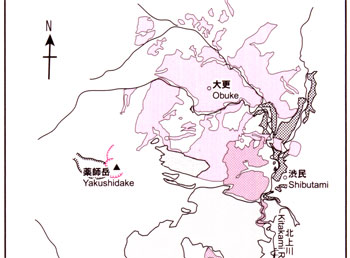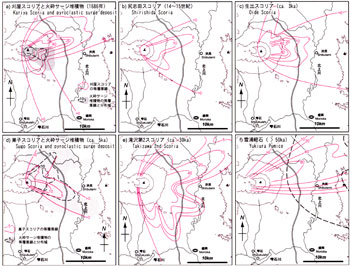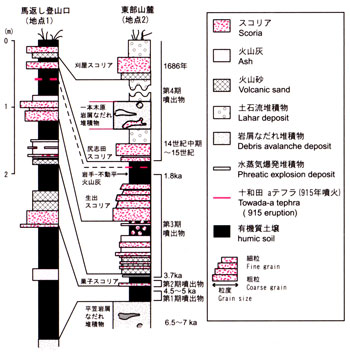Iwate Volcano
1: Introduction / 2: Geology of Iwate Volcano / 3: Outline of Iwate Volcano
4: Eruption history of Iwate Volcano
5: Eruptions of historical times / 6: Latest activities
7: Monitoring of volcanic activities / 8: Points to be watched for mitigation of disaster
Acknowledgment / References
![]() PREV
PREV ![]() NEXT
NEXT
4: Eruption history of Iwate Volcano
Volcanic activity of each stage is described below in ascending order.
4.1 Nishi-Iwate - Onigashiro stage
In the eruptive stage, during which Nishi-Iwate Volcano was formed, the ejecta were mainly andesitic lava flows and pyroclastic falls. Several small scale pyroclastic flow deposits were also produced. Towards the end of the stage a small basaltic volcano ( Kurokura Volcano ) was formed.
During this stage, at least four large-scale collapses occurred and the resultant materials spread on surrounding areas. Those deposits are named Gohyakumori debris avalanche deposits and distributed mainly in east to northeast areas ( about 190,000 years old ), Aoyamacho debris avalanche deposits in east to southeast areas ( about 150,000 years old ), Shizukuishi debris avalanche deposits in south areas, although mostly outside of the map area ( about 130,000 years old ), and Oishiwatari-Koiwai debris avalanche deposits in east to southeast areas( about 120,000 years old ) in ascending order.
4.2 Higashi-Iwate - Onimata stage
Basaltic ejecta produced Onimata Volcano burying collapse caldera from which Ooishiwatari-Koiwai debris avalanche deposits originated. Duration of activity is estimated to be from 120,000 to 90,000 yBP.
4.3 Nishi-Iwate - Omisaka stage
After the formation of Onimata Volcano a new activity started from about 80,000 yBP in Nishi-Iwate Volcano. At the valley head of Omisaka River, a small andesitic volcano ( Omisaka Volcano ) was formed unconformably overlying Onimata Volcano. Although the source is not clear, andesitic-dacitic pyroclastic flow deposits ( Shinogamori pyroclastic flow deposits ) of calc-alkaline rock series and Yukiura Pumice deposited.
4.4 Nishi-Iwate - Onashiro stage
Although details of how it was formed are not very clear, after the formation of Nishi-Iwate caldera at the center of Nishi-Iwate Volcano, eruptive activities within the caldera led to the formation of a group of central cones. Center of eruption is estimated to be at the location where Lake Onashiro occupies now. Initially lavas extruded from Oojigokudani area formed a small mountain. Lavas are calc-alkaline andesites such as Yakikirizawa lava and Onashiro lava followed by tholeiitic andesites such as Okama lava and Kanazawa pyroclastic flow. Onashiro lava and Okama lava are both thick ( lava dome ) with multiple craters existing at the summit. Kanazawa pyroclastic flow deposit is a small-scale pyroclastic flow showing scattered distribution on the NE foot and its age is estimated to be about 30,000 yBP.
4.5 Higashi-Iwate - Hirakasa Fudo stage
About 30,000 yBP, NE part of Nishi-Iwate Volcano collapsed forming Yamakozawa debris avalanche. After this, Hirakasa Fudo Volcano was formed by 20,000 yBP with its center around the place where current Yakushidake stands. Hirakasa Fudo Volcano is a basaltic stratovolcano overlying Nishi - Iwate Volcano in the north and Onimata Volcano in the south.
4.6 Nishi-Iwate - Oojigokudani stage
As a result of intensive fumarolic and geothermal activities, at least several phreatic explosions occurred in Oojigokudani since 7,000 yBP. Crater topography and thick ejecta including altered rocks resulted from phreatic explosions are recognized around Oojigokudani. Ash falls from large-scale phreatic explosions reached eastern foot of Higashi-Iwate Volcano.
4.7 Higashi-Iwate - Yakushidake stage
About 7,000 yBP, Hirakasa Fudo Volcano collapsed towards NE resulted in Hirakasa debris avalanche. Volcanic activities following this event formed Yakushidake Volcano. Ejecta from this volcano filled most of collapse caldera from which Hirakasa debris avalanche originated. Part of the ejecta reached even Nishi-Iwate caldera. Based on the tephra deposits on the foot area, the volcanic activities can be divided into four sub-stages separated by comparatively quiet periods.
The first sub-stage ejecta is mainly first Yakushidake lavas which is distributed in N to NE foot areas ( some in eastern foot ) about 6,000 to 5,000 yBP. The second sub-stage ejecta include Sugo scoria and accompanying pyroclastic surge deposits, and second Yakushidake lavas of 5,000 to 4,000 yBP. The third sub-stage ejecta consist of Yakushidake scoria hill, Oide scoria, and third Yakushidake lavas of 3,700 to 1,800 yBP. Yakushidake scoria includes lava and agglutinate forming the summit of Yakushidake. Part of lava flowed down to eastern foot. Oide scoria is coarse-grained multiple scoria fall deposits and distributed in SE to NE areas of Yakushidake. Third Yakushidake lavas were erupted after the eruption of Oide scoria and distributed in NE rim of Yakushi crater, Fudodaira, and north and east foot areas. Towards the end of these activities, a little amount of silicic glassy ash ( Yakushidake - Fudotaira ash ) was ejected. Following nearly 1,000 years' dormant period after third Yakushidake lavas, fourth Yakushidake activity commenced from about 14th to 15th century. This is continuing today ( ![]() Table 2 ).
Table 2 ).



